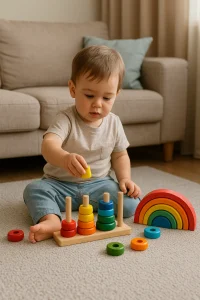Making Your Home Autism-Friendly: A Sensory-Safe Space Guide
By Rajini D
Last Updated: April 22, 2025
Imagine a space where your child feels calm, safe, and understood—a place where meltdowns are less likely and daily routines bring comfort instead of stress. That’s the heart of an autism-friendly home: a thoughtfully designed environment that supports your child’s sensory needs, encourages independence, and reduces overwhelm. In this guide, we’ll show you how small changes—like soft lighting, calming colors, and structured routines—can transform your home into a sensory-safe space where your child can truly thrive.
So, What Does “Autism-Friendly Home” Really Mean?
An autism-friendly home is designed with sensory comfort, structure, and safety in mind. It helps children (and adults) on the autism spectrum feel more at ease by reducing everyday stressors like loud noises, bright lights, or sudden changes in routine.
This kind of environment isn’t about fancy gadgets or overhauling your entire house. It’s about small, thoughtful adjustments that create a predictable, sensory-safe environment where your child can thrive.
Why Does It Matter?
Children with autism often see and experience the world differently. Everyday sights, sounds, and textures that feel normal to us might be overwhelming for them. That’s why their surroundings matter so much.
Creating an autism-safe environment can help:
- Reduce anxiety and meltdowns
- Support better focus and behavior
- Encourage independence and confidence
- Improve sleep and daily routines
- Strengthen the bond between parent and child
Our online autism therapy services offer personalized support to help children manage sensory and emotional challenges in daily life.
Here’s a quick comparison to help you see the difference:
| Typical Home Setup | Autism-Friendly Home Setup |
|---|---|
| Bright overhead lighting | Soft, adjustable lighting |
| Cluttered, noisy spaces | Clear, calm, and organized rooms |
| Open-ended routines | Structured, visual daily routines |
| Sharp corners or unsafe items | Child-safe design and calm zones |
The Role of Structure and Routine
Children on the autism spectrum often find comfort in predictability. That’s why routines are such a big deal. Knowing what to expect helps them feel more in control, which reduces stress and supports emotional regulation.
A few ideas to try at home:
- Use visual schedules to show daily activities
- Keep meal and sleep times consistent
- Prepare your child for changes in advance
- Create a calming corner for breaks or quiet time
Understanding Sensory Needs in Autism
What is a Sensory-Safe Space?
If your child is on the autism spectrum, you’ve likely seen how certain sounds, lights, or textures can lead to discomfort—or even a full meltdown. That’s where a sensory-safe space comes in.
A sensory-safe space is a calm, predictable environment designed to reduce overwhelming input. It helps your child feel more relaxed and in control. These spaces are especially important for kids with autism sensory issues, who may have a harder time filtering sights, sounds, and physical sensations.
Think of it as your child’s personal comfort zone—a place they can go when the world feels “too much.”
Common Sensory Triggers to Watch For:
Different children react to different things, but here are some everyday triggers that may cause distress:
- Loud or sudden noises (TV volume, doorbells, vacuum cleaners)
- Harsh lighting (fluorescent lights, flickering bulbs)
- Uncomfortable textures (itchy clothes, sticky surfaces, certain fabrics)
- Crowded or cluttered spaces
- Temperature extremes (very hot or cold environments)
By recognizing and minimizing these triggers, you’re already on your way to building a more autism-friendly environment at home.
Signs Your Child May Need a Sensory-Friendly Setup
Not every child can tell you when something feels “too much.” But their behavior often speaks for them.
Here are some signs that your child might benefit from a sensory-friendly space:
- Frequent meltdowns after noisy or busy environments
- Shutdowns—suddenly becoming quiet, withdrawn, or frozen
- Covering ears or eyes to block input
- Trying to escape the room or hide
- Resistance to being touched or trying new clothes
- Trouble sleeping due to sound, light, or texture discomfort
These are all indicators of sensory overload, and a dedicated space that feels safe and quiet can make a big difference in how your child copes.
Not sure where to start? Try our free autism screening test to better understand your child’s needs.
Key Elements of an Autism-Friendly Home Design
Creating an autism-friendly home doesn’t mean a full renovation—it’s about making thoughtful, sensory-safe changes that support your child’s comfort, focus, and emotional well-being. Let’s break it down into simple, doable steps.
Use of Soft Colors and Calming Light
One of the easiest ways to create a calming environment at home is by adjusting the colors and lighting.
Avoid Harsh Lighting
Bright, flickering lights (especially fluorescent ones) can be overwhelming for children with sensory sensitivities. Try this instead:
- Use warm-toned LED bulbs
- Install dimmers to control brightness
- Choose natural lighting when possible
- Avoid direct overhead lights—use floor or table lamps for a softer glow
Calming Color Choices
Certain colors help reduce stress and make your home feel more peaceful.
| Calming Colors | Why They Work |
|---|---|
| Soft blues | Promotes relaxation and focus |
| Muted greens | Associated with nature & calm |
| Warm neutrals | Feel safe and non-distracting |
Creating a Quiet and Safe Space
A dedicated quiet space for autism can act like a reset button when things feel too overwhelming.
Ideas for a Calming Corner:
- Use a small tent, teepee, or even a cozy nook with pillows
- Add familiar comfort items like soft blankets or favorite stuffed animals
- Include dim lighting or string fairy lights
- Let your child help choose what goes in—it gives them a sense of control
Simple Soundproofing Tips:
- Use thick rugs or carpet to absorb noise
- Hang curtains or fabric wall panels
- Add bookshelves or cushions along walls to reduce echoes
- Consider noise-canceling headphones during busy times
Sensory Tools and Furniture
Some kids find certain textures or movements soothing. That’s where autism tools for home come in.
Common Sensory-Friendly Tools:
- Weighted blankets – Help with calming and sleep
- Bean bags or rocking chairs – Offer gentle motion and comfort
- Fidget toys or sensory bins – Reduce anxiety and improve focus
- Body socks or compression vests – Provide deep pressure input
Here’s a quick guide:
| Tool | When to Use |
|---|---|
| Weighted blanket | During naps or bedtime for calming |
| Fidget toys | During study time or car rides |
| Bean bag chair | Reading, watching TV, or downtime |
| Sensory swing | Supervised play or post-meltdown reset |
These tools can be paired with online speech therapy for kids to support communication alongside sensory development.
DIY Autism-Friendly Home Modifications
You don’t need a big budget or a design degree to create a home that feels safe and comforting for your autistic child. A few small, thoughtful changes can go a long way. Let’s look at some simple autism-friendly home modifications you can start today.
Simple and Budget-Friendly Changes
Many of the most helpful adjustments are easy and affordable. You just need to look at your home through your child’s eyes.
Here are some parent-approved, low-cost ideas:
Declutter and Simplify
- Keep surfaces tidy and organized
- Store toys and supplies in labeled bins or boxes
- Use closed storage to reduce visual noise
Reduce Unwanted Noise
- Add rugs, cushions, and curtains to absorb sound
- Use door stoppers or soft-close cabinet bumpers
- Consider a small white noise machine or calming background music
Use Clear Visual Labels
- Label drawers and cabinets with pictures and words
- Use color-coded bins for toys, clothes, and snacks
- Create step-by-step picture guides for routines like brushing teeth or getting dressed
Learn how sensory integration techniques can help create a more peaceful home environment.
Tips for Every Room (Bedroom, Kitchen, Bathroom)
Every part of your home can be a little more sensory-friendly with the right tweaks. Here’s how to make key rooms work better for your child:
Autism-Friendly Bedroom
A peaceful bedroom can support better sleep and self-regulation.
- Use blackout curtains or a sleep tent to block light
- Choose weighted blankets or familiar bedding
- Add a small calming corner with books, stuffed toys, or a sensory swing
- Keep walls in soft, neutral tones for a calming environment
Kitchen
The kitchen can be overwhelming with bright lights and loud appliances, but a few changes help.
- Use soft lighting instead of overhead fluorescents
- Create a “safe zone” away from hot surfaces or sharp tools
- Offer choices visually (e.g., snack bins with pictures)
- Keep the setup consistent to avoid surprises
Bathroom
Bathrooms can be challenging due to textures, smells, and sounds.
- Use a non-slip, soft-texture bath mat
- Store items in labeled, easy-to-reach baskets
- Try unscented soaps or shampoos if your child is sensitive to smells
- Install a dimmable light or use a lamp for softer lighting
You can find more practical suggestions in our autism parenting tips blog to adapt everyday routines
Involving Your Child in the Design Process
Creating an autism-friendly space is more than just picking the right paint or sensory tools—it’s about helping your child feel a sense of ownership and comfort. And one of the best ways to do that? Let them take the lead in small ways.
Why Child-Led Design Matters
When your child helps shape their space, they’re more likely to:
- Feel safe and in control
- Use the space regularly and meaningfully
- Build independence and confidence
- Experience fewer meltdowns or resistance to routines
Even simple choices can go a long way in child-led home design.
Let Them Choose: Simple Ways to Involve Your Child
You don’t have to hand over every decision—but giving your child a few options makes them feel included and empowered.
Here are easy, low-stress ways to involve your child:
- Let them pick a calming color for their walls or bedding
(Offer two or three sensory-friendly choices like soft blue, muted green, or beige.) - Allow them to choose favorite textures for blankets, bean bags, or cushions
- Let them decorate their quiet space with comforting items like photos, drawings, or soft toys
- Involve them in setting up routines, using picture charts or visual schedules they help design
- Ask for input on where to place calming tools like fidget bins or sensory swings
This process doesn’t have to be perfect. It’s about making the space feel like theirs.
Keeping It Personal and Safe
While freedom is important, safety and comfort should still come first. As you involve your child, gently guide them toward sensory-friendly choices that support their needs.
For example:
- Choose weighted blankets that feel cozy but not too heavy
- Opt for soft lighting even if they love colorful bulbs—use a filter or dimmer
- Stick to non-slip rugs if they want to decorate the floor
- Create clear, labeled storage so everything has a “home”
Conclusion
Creating a sensory-safe home for your autistic child doesn’t need to be hard or expensive. Start small—add soft lighting, clear labels, or a calming corner. These little changes can make a big difference in your child’s comfort and behavior. Let them help choose colors or tools to make the space feel like theirs. Need help? At Wellness Hub, our experts guide you step-by-step. You can also explore our speech and communication tests to better understand your child’s needs. Your home can be a calm, safe, and happy place—one simple step at a time.
Frequently Asked Questions:
1. What does an autism-friendly home mean?
An autism-friendly home is a place where your child feels safe, calm, and supported. It’s designed to reduce stress by limiting things that may cause sensory overload, such as loud sounds, bright lights, and clutter. This type of environment helps your child feel more relaxed and improves their focus, mood, and daily routines.
2. How do I make my home sensory-safe for my autistic child?
To create a sensory-safe space, begin with small changes:
- Use soft, warm lighting instead of bright bulbs
- Choose calming colors like blue or green
- Keep noise levels low by using rugs or curtains
- Create a quiet corner with pillows or soft toys
Adding these simple touches can help your child feel secure and reduce anxiety at home.
3. Why is lighting important in an autism-friendly room?
Many children on the autism spectrum are sensitive to light. Harsh or flickering lights can cause discomfort or even trigger meltdowns. Using soft, adjustable lighting helps create a calming environment. Table lamps, fairy lights, or natural sunlight are great choices for an autism-friendly room.
4. Which colors are calming for autistic children?
Colors play a big role in how your child feels. For a sensory-friendly home design, try soft and soothing colors like:
- Light blue (for calm and focus)
- Muted green (for relaxation)
- Beige or soft grey (for comfort and safety)
Avoid using bright red, yellow, or patterns that may feel overwhelming.
5. How can I make a quiet space for my child at home?
A quiet space gives your child a safe spot to calm down. You can create one by:
- Picking a cozy corner in the bedroom or living room
- Adding soft cushions, blankets, or a bean bag
- Keeping the area free from noise and clutter
This sensory-safe room helps your child rest, read, or take a break when things feel too much.
6. What are some low-cost autism-friendly home changes I can try?
You don’t need a big budget to make a difference. Try these budget-friendly autism home modifications:
- Declutter rooms to reduce visual distractions
- Label drawers and shelves with pictures
- Use rugs to reduce noise
- Set a simple daily routine using visual charts
Even small steps can make your home more autism-friendly and comfortable.
7. What sensory tools should I use at home for autism?
Sensory tools help your child feel more regulated and focused. Here are some helpful items:
- Weighted blanket – promotes calm and better sleep
- Fidget toys – great for focus during study or travel
- Bean bag or swing – offers deep pressure or movement
- Noise-canceling headphones – useful in busy environments
These autism tools for home support your child’s sensory needs and improve daily routines.
8. Should I let my child choose how their space looks?
Yes! Letting your child make small choices—like picking wall colors or favorite cushions—helps them feel more in control. Child-led home design creates a personal, safe space where your child feels happy and heard. It also builds confidence and helps them enjoy their room more.
9. Can home changes reduce autism meltdowns?
Yes. A calm and predictable environment can reduce triggers that lead to meltdowns or shutdowns. Simple changes—like soft lighting, quiet corners, or visual routines—help lower your child’s stress and make transitions smoother. These changes support better behavior and emotional control.
10. Where can I get help designing an autism-friendly home?
If you’re unsure where to start, you’re not alone. At Wellness Hub, we offer free consultations to help families create sensory-friendly environments. Our experts can guide you on everything from daily routines to therapy tools for home.
About the Author:
Rajini Darugupally
M.Sc., Speech-Language Pathologist (9+ years of experience)
Rajini is a passionate and dedicated Speech-Language Pathologist with over 9+ years of experience, specializing in both developmental speech and language disorders in children and rehabilitation in adults. Driven by a desire to empower each individual to find their voice, Rajini brings a wealth of experience and a warm, genuine approach to therapy. Currently, at Wellness Hub, she thrives in a team environment that values innovation, compassion, and achieving results for their clients.
Book your Free Consultation Today
Parent/Caregiver Info:
Client’s Details:
* Error Message









